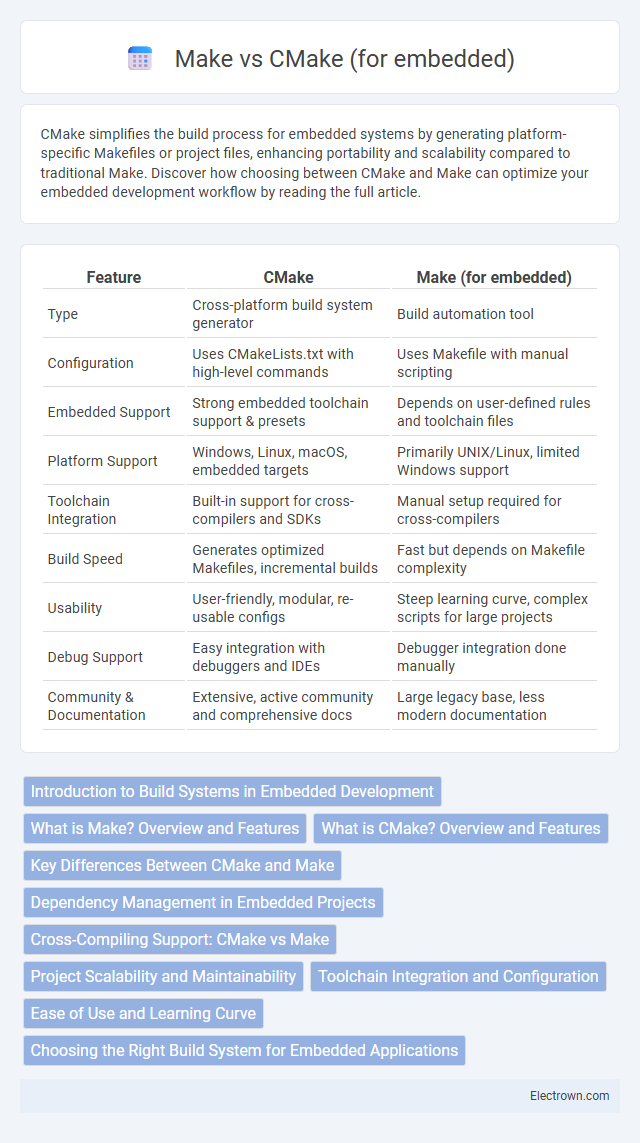CMake simplifies the build process for embedded systems by generating platform-specific Makefiles or project files, enhancing portability and scalability compared to traditional Make. Discover how choosing between CMake and Make can optimize your embedded development workflow by reading the full article.
Table of Comparison
| Feature | CMake | Make (for embedded) |
|---|---|---|
| Type | Cross-platform build system generator | Build automation tool |
| Configuration | Uses CMakeLists.txt with high-level commands | Uses Makefile with manual scripting |
| Embedded Support | Strong embedded toolchain support & presets | Depends on user-defined rules and toolchain files |
| Platform Support | Windows, Linux, macOS, embedded targets | Primarily UNIX/Linux, limited Windows support |
| Toolchain Integration | Built-in support for cross-compilers and SDKs | Manual setup required for cross-compilers |
| Build Speed | Generates optimized Makefiles, incremental builds | Fast but depends on Makefile complexity |
| Usability | User-friendly, modular, re-usable configs | Steep learning curve, complex scripts for large projects |
| Debug Support | Easy integration with debuggers and IDEs | Debugger integration done manually |
| Community & Documentation | Extensive, active community and comprehensive docs | Large legacy base, less modern documentation |
Introduction to Build Systems in Embedded Development
Build systems in embedded development automate compiling and linking source code, optimizing efficiency and reproducibility across diverse toolchains and hardware architectures. Make utilizes simple, readable Makefiles that define dependencies and commands, offering straightforward control but limited scalability for complex projects. CMake generates native Makefiles or project files, facilitating cross-platform builds, modular code organization, and integration with embedded toolchains, making it ideal for advanced embedded systems development.
What is Make? Overview and Features
Make is a widely-used build automation tool that directs the compilation process by reading instructions from Makefiles, specifying dependencies and build rules for embedded systems. It efficiently manages incremental builds, recompiling only the modified source files, which speeds up development cycles in resource-constrained embedded environments. Make supports complex build configurations, parallel execution, and integration with various compilers, making it a versatile choice for embedded software projects.
What is CMake? Overview and Features
CMake is an open-source, cross-platform build system generator designed to manage the build process of complex embedded software projects efficiently. It uses configuration files called CMakeLists.txt to describe the build parameters and dependencies, allowing for automated, reproducible builds across different environments and toolchains. Key features include support for out-of-source builds, integration with various compilers, modular configuration, and ease of use in cross-compilation scenarios typical in embedded development.
Key Differences Between CMake and Make
CMake generates platform-specific build files, including Makefiles, enabling greater flexibility and reuse across multiple embedded systems, while Make directly processes Makefiles for incremental builds. CMake supports modern project structures and automatically manages dependencies, reducing manual configuration typical in Make. Your embedded project benefits from CMake's cross-platform capabilities and easier maintenance compared to traditional Make's straightforward but less adaptable approach.
Dependency Management in Embedded Projects
CMake offers advanced dependency management in embedded projects by automatically handling include paths, libraries, and external modules, reducing manual configuration errors common in Make. Its built-in support for finding and versioning dependencies simplifies cross-platform builds and integrates seamlessly with package managers like CPM or vcpkg. Make requires explicit rules for dependency tracking, which can grow complex and error-prone in embedded systems with numerous hardware-specific components.
Cross-Compiling Support: CMake vs Make
CMake offers robust cross-compiling support through its built-in toolchain files, enabling seamless configuration of compilers, linkers, and environment variables for embedded targets. Make relies heavily on manually crafted Makefiles, requiring explicit specification of cross-compiler prefixes and environment settings, which can increase maintenance complexity in embedded projects. CMake's abstraction and automation simplify managing diverse embedded platforms and toolchains compared to Make's more manual approach.
Project Scalability and Maintainability
CMake offers superior project scalability and maintainability compared to Make, especially for embedded development, by providing a higher-level abstraction that simplifies managing complex build configurations across multiple platforms. Its modular approach enables your embedded projects to easily incorporate libraries, handle dependencies, and adapt to changing requirements without extensive manual intervention. Using CMake enhances your project's long-term maintainability by generating native build files tailored to specific environments, reducing errors and streamlining collaborative development.
Toolchain Integration and Configuration
CMake offers superior toolchain integration and configuration flexibility for embedded development by allowing developers to define custom toolchain files that specify compiler, linker, and debugger settings tailored to specific hardware platforms. Unlike Make, which requires manual editing of Makefiles for each embedded toolchain, CMake automates the detection and setup of cross-compilers, resulting in streamlined, reproducible build environments. Its support for complex dependency management and multi-platform builds enhances productivity and reduces configuration errors in embedded projects.
Ease of Use and Learning Curve
CMake offers a higher-level abstraction with cross-platform support, making it easier for embedded developers to manage complex projects and dependencies compared to Make's straightforward but manual scripting style. Make requires in-depth knowledge of Makefile syntax and is less intuitive for beginners, whereas CMake's declarative syntax and extensive documentation reduce the learning curve significantly. The integration of CMake with modern IDEs further accelerates development workflows, whereas Make is often preferred for its simplicity in small or legacy embedded projects.
Choosing the Right Build System for Embedded Applications
CMake and Make offer distinct advantages for embedded applications, with CMake providing a higher-level, platform-independent build configuration that simplifies cross-compilation and dependency management. Make excels in low-resource environments due to its simplicity and direct control over build steps, which can be critical for embedded systems with strict hardware constraints. Evaluating your project's complexity, target hardware, and development workflow helps determine whether CMake's automation or Make's minimalism better suits your embedded build needs.
CMake vs Make (for embedded) Infographic

 electrown.com
electrown.com